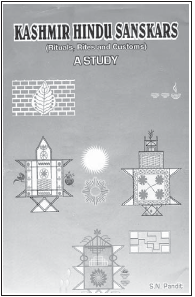Kashmir
Hindu Sanskars (Rituals, Rites and Customs): A Study
By Upender Ambardar
The book under review titled as 'Kashmir Hindu
Sanskars' (Rituals, Rites and Customs): A study is authored by Sh. S.N. Pandit.
Before emarking upon the review of the said book, it is imperative to have a
clear understanding of religion, culture, Sanskars, ritual rites and customs,
which are altogether distinct and separate entities.

S.N. Pandit
Etymologically, the word religion comes close to the
meaning of 'dharma', originating from the Sanskrit root word 'Dhar' meaning to
garner, to consolidate, to integrate, to sustain, to blend, to guard, to shield,
to preserve or to safeguard. Religion is also said to be the cosmic order of the
entire reality, rather it is a triad of the body, soul and the spirit. In other
words, religion upholds and sustains the people by blending one's self with the
divine supreme. In addition to it, religion also reaffirms the bond and link
between the physical body, the soul which dwells in the body and the Divine
Spirit. Religion is also supposed to cement our association with the entire
humanity the universe in which we live and innumerable manifestations along with
the associated unexplainable mysteries
Another term in vogue i.e 'Sanatan Dharma', which
signifies an ancient revered tradition along with the accompanying spiritual
pursuit, which encompasses the entire universe, the land in which we live, the
country and the society in addition to the whole set of families and the
relationships. The famous Sanskrit saying 'Vasudhaiva Kutumbakam i.e. the whole
universe is my family and that all beings, are one bears testimony to this
concept of 'Sanatan Dharma'. All the religions have three aspects of philosophy,
rituals and mythology, among which philosophy runs same in all the religions
with rituals and mythology exhibiting variations. Next comes culture, which in
my opinion is a face-up to the past, which prepares us for the future. Culture
is a complex interplay of diverse components of customs, rituals, ceremonies,
beliefs, taboos and codes of social habits and conduct along with the related
institutions and methodological activities. It is the culture, which acts as a
lever to enforce the people to adhere to the socially acceptable moral, ethical
and principled norms. The expressive strategy is one of the aspects of culture,
which includes music, dance, art, literature and above all the mother tongue.
Lastly, culture encourages and inspire the people of a particular set-up to
interpret the individual and social life meaningfully.
The quality of excellence of culture is determined by
rituals, rites and
 customs, which enrich our lives by nourishing our souls and
in the process give a purposeful meaning to our time-tested traditional values.
The rituals, rites and customs are a set of rules and norms of conduct, which
ensure the cultural welfare of a social group or a community by guiding our
everyday actions. They are invaluable and helpful for our mental, physical,
psychological and spiritual well-being. Having a strong emotional base, they are
interwoven in the matrix of our social and cultural lives. As such, they provide
socio-cultural directions that give strength and might to the community. Last
but not the least are the Sanaskars, which are integrated acts of purification
of the mind, which help in self-realisation. Sanskars leave a permanent and
everlasting impression on the mind. They are acquired gradually and slowly
either by scriptures but mostly by observations. They not only connect us with
the past but also force us on the righteous path. Now coming to the book titled
"Kashmir Hindu Sanskars", authored by Sh SN Pandit is a whooping 461 pages tome,
thoughtfully structured into seventeen chapters and is priced at Rs 475. customs, which enrich our lives by nourishing our souls and
in the process give a purposeful meaning to our time-tested traditional values.
The rituals, rites and customs are a set of rules and norms of conduct, which
ensure the cultural welfare of a social group or a community by guiding our
everyday actions. They are invaluable and helpful for our mental, physical,
psychological and spiritual well-being. Having a strong emotional base, they are
interwoven in the matrix of our social and cultural lives. As such, they provide
socio-cultural directions that give strength and might to the community. Last
but not the least are the Sanaskars, which are integrated acts of purification
of the mind, which help in self-realisation. Sanskars leave a permanent and
everlasting impression on the mind. They are acquired gradually and slowly
either by scriptures but mostly by observations. They not only connect us with
the past but also force us on the righteous path. Now coming to the book titled
"Kashmir Hindu Sanskars", authored by Sh SN Pandit is a whooping 461 pages tome,
thoughtfully structured into seventeen chapters and is priced at Rs 475.
It covers a huge range of subjects ranging from 'Garbadhana'
i.e. very conception for life to the last and final stage of life. The book
under review is a recounting of religio-social cultural history of Kashmiri
Pandits, enfolding a fascinating and detailed account of almost every aspect of
our ritual, rite and custom.
Perhaps, it is for the first time that the said book
gives a telling insight into everything connected with our customs and rituals,
providing an in-depth chronicle of our daily lives. The book gives a clear
understanding of the daily rituals and rites meant both for men and women,
supposed to be performed from dawn to dusk. The author in introduction dwells on
the past history by describing Kashmiri Pandits - the Saraswat Brahmins as the
direct descendents of Kashyap Rishi. The introductory narrative also unfolds the
point that at the onset of first Manvantra, the nine rishis namely Maricha, Atri,
Angira, Pulastya, Vishvamitra, Bhardwaja, Gautama and Jamedagni were the first
to inhabit the drained-out
land of
Satidesha.
The author also enlightens us that though sixteen Sanskars are in vogue among
Hindus outside Kashmir but in contrast to it, Kashmiri Pandits have twenty four
Sanaskars to guide them right from the conception and birth to death.
In the journey of life, these Sanskars are signboards
that indicate directions to be followed at various stages of life. The chapter
two covers almost all the rituals right from the pre-natal Sanaskars and rituals
starting from 'Bijwapan/Garbhadan to the post-birth rituals of 'Truy' (third day
after birth, 'Shransondar' (ritualistic bathing), 'Kaha-Nethir' (Jatakarn), 'Namkaran',
'Nishkraman or 'Masi-Nyathir', 'Tsatjihim Shran' (ritualistic bath for both
mother and child after forty days), 'Aniprashun', 'Kun-Chomban', 'Voharvod
(birthday) and 'Zarikasay'. In the chapter three of the said book, the author Sh.
S.N. Pandit familiarises the reader with the philosophical, historical and
religious background of all the rituals connected with 'Yagnopavita'' ceremony
starting from the chopping of fire-wood (Zyun-Tsatun), the shopping on the
auspicious day, 'Dapun' or the ritualistic invitation to the guests, 'Gari-Navay'
or cleaning of the house, 'Mehndiraat', 'Devgon' (rites invoking blessings of
God), 'Hawan Shalla for the Yagnopavita and the actual thread ceremony ending
with the 'Koshalhom' ceremony. In the subsequent chapters numbered fourth, fifth
and sixth, a wide range of insightful information is also given by the author Sh
SN Pandit - starting right from the ritual of matching of horoscopes or 'Tekin-Milnavin',
engagement or 'Kasam-driay', 'hair-dressing' or 'Mus-Muchravan, 'Lagni Chir' or
intimation for marriage date and timings, the arrival and reception of 'barat',
the significance of the decorative welcome sign of 'Vyug', feasting of the
guests, the ritualistic pooja at the door of the bride's house, 'Kanya-dan
function', 'Athavass' or holding of the hands by the bride and the bride-grooms,
'Saft-padi' or seven steps undertaken by the groom and the bride jointly, 'Dayi-bata'
or sharing of the food by the groom and the bride, 'Posha-pooja', and lastly
departure of the barat. The author also gives a telling account of the
post-marriage functions and ceremonies in the chapter six, which comprise of 'Kadil-tar'
or crossing of the bridge on way to the bride-grooms' home, 'Zam-brandh' or
gratifications to the groom's sister, 'Maet-mohar' or presents for the
mother-in-law, 'Trunk-Havun or display of the dowry, 'Sutrath', 'Roth-Khabur' or
welfare information, 'Phir-Sal' or first invitation to the son-in-law and 'Ghar-atchun'
or formal feasting at the the respective homes of the bride and the groom.
The festivals and occasisons during the first year of
marriage like birthday, 'Netri-Vohravodh' or the first marriage anniversary, 'Shravni-punim'
or Raksha-bandhan, 'Zarma-Satam' or Janam-Ashtami, 'Shishur-lagun' or ritual at
the advent of winter, 'Shivratri', 'Navreh', 'Zangtrai' i.e. third day of 'Navreh',
inaddition to the functions of the occasion nature like 'Nav-sheen' i.e. first
snowfall etc. have also been detailed by the author. Sh. S.N. Pandit, the author
also gives good insight in the rituals and customs pertaining to death like 'Anteshti',
'Dah-Sanaskar' or cremation, collection of the mortal remains and subsequent
immersion at 'Sangam', bathing and washing of clothes known as 'Chalun', tenth,
eleventh and twelfth day rituals, the fortnightly and monthly rituals of 'Pachvar',
'Maaswar', rituals at the end of six months i.e. 'Shudmos', 'Vaharvahar' or
rituals at the end of one year and lastly 'Shradh' or the death anniversary.
Th said book also successfully captures the entire
gamut of the festivals and asupicious occasions of the year like 'Shivratri,
Navreh, Zang-trai, Durgaashtami, Ramnavami, Baisakhi, Nirjala-ekadashi, Mela
Khir Bhawani, Ashad Navami, Ashad Chaturdash, Raksha-Bandhan, Janam Ashtmi ,
Vinayak Chaturthi, Veth Truvah, Navratra, Vijay Dashmi, Dipawali, Gada Batta,
Kyhetchri-mavas, Shishar-Sankrath, Thal-Barun and Kaw-Punim etc.
The inclusion of the information regarding the
auspicious moments like 'Saath-Vuchun', superstitions, taboos, lunar and solar
eclipses, 'Malamas' and 'Banamas' etc. reflects author's social awareness and
denotes his successful attempt to reach-out fully to his community members with
his descriptive narration. In the concluding chapter, the author familiarizes
the reader with different planets and their consequent effect in various zodiac
positions. Lastly coming to the cover of the book, I am reminded of Turkish
writer Orhan Pamuk's assertion that book covers are like faces, the more
attractive, colourful and captivating one's are fast selling. The book under
review has an appealing and alluring bright coloured cover displaying holy signs
and diagrammatic representations of the Yagnya-Shalla, in addition to an
abstract of the 'Kalash' etc.
In short, the book 'Kashmir
Hindu Sanskars',
written by Sh. S.N. Pandit is a valuable guide that tells us everything about
our culture, heritage, traditions, rituals, customs and festivals. It is a book
for all and everyone. It is packed with graphic details, fascinating facts and
information rendered in sequential order. The relevant folk songs on the
occasion and the rituals with accompanying english translation is its added
charm.
Painstaking study and investigation has been
undertaken by the author to prepare this cultural treatise, which makes the book
to stand-out from the rest. Unarguably, the book will serve as a base material
for further research about the rituals, rites and customs of Kashmiri Pandits.
Source: Kashmir
Sentinel
|
